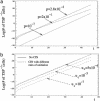The optimal rate of chromosome loss for the inactivation of tumor suppressor genes in cancer
- PMID: 15105448
- PMCID: PMC406458
- DOI: 10.1073/pnas.0401943101
The optimal rate of chromosome loss for the inactivation of tumor suppressor genes in cancer
Abstract
Many cancers are characterized by chromosomal instability (CIN). This phenotype involves the deletion and duplication of chromosomes or chromosome parts and results in a high degree of aneuploidy. The role of CIN for cancer progression is a very important, yet unresolved question. It has been argued that CIN contributes to cancer initiation because chromosome loss can unmask a mutated tumor suppressor (TSP) gene. At the same time, CIN is costly for the cell because it destroys the genome and therefore compromises clonal expansion. Here, we use mathematical models to determine whether CIN can accelerate the generation and expansion of TSP(-/-) cells in the context of this tradeoff. Comparing cells with different degrees of CIN, we find that the emergence and growth of TSP(-/-) cells is optimized if the rate of chromosome loss is of the order of 10(-3) to 10(-2). This result is very robust, is independent of parameter values, and coincides with experimental measures using colon cancer cell lines. However, if we consider all of the steps in the pathway, including the generation of the CIN phenotype from stable cells, then it turns out that the emergence and growth of TSP(-/-) cells is never accelerated by CIN. Therefore, CIN does not arise because it accelerates the accumulation of adaptive mutations. Instead, it arises for other reasons, such as environmental factors, and is subsequently fine-tuned by selection to minimize the time to further cancer progression by means of the inactivation of TSP genes.
Figures



Similar articles
-
Can chromosomal instability initiate tumorigenesis?Semin Cancer Biol. 2005 Feb;15(1):43-9. doi: 10.1016/j.semcancer.2004.09.007. Semin Cancer Biol. 2005. PMID: 15613287 Review.
-
Chromosome instability and tumor lethality suppression in carcinogenesis.J Cell Biochem. 2008 Dec 15;105(6):1327-41. doi: 10.1002/jcb.21937. J Cell Biochem. 2008. PMID: 18821574
-
Persistent increase in chromosome instability in lung cancer: possible indirect involvement of p53 inactivation.Am J Pathol. 2001 Oct;159(4):1345-52. doi: 10.1016/S0002-9440(10)62521-7. Am J Pathol. 2001. PMID: 11583962 Free PMC article.
-
Mechanisms of chromosome instability in cancers.Crit Rev Oncol Hematol. 2006 Jul;59(1):1-14. doi: 10.1016/j.critrevonc.2006.02.005. Epub 2006 Apr 4. Crit Rev Oncol Hematol. 2006. PMID: 16600619 Review.
-
Evidence that both genetic instability and selection contribute to the accumulation of chromosome alterations in cancer.Carcinogenesis. 2005 May;26(5):923-30. doi: 10.1093/carcin/bgi032. Epub 2005 Jan 27. Carcinogenesis. 2005. PMID: 15677628
Cited by
-
Stress-induced mutagenesis and complex adaptation.Proc Biol Sci. 2014 Oct 7;281(1792):20141025. doi: 10.1098/rspb.2014.1025. Proc Biol Sci. 2014. PMID: 25143032 Free PMC article.
-
Determinants and clinical implications of chromosomal instability in cancer.Nat Rev Clin Oncol. 2018 Mar;15(3):139-150. doi: 10.1038/nrclinonc.2017.198. Epub 2018 Jan 3. Nat Rev Clin Oncol. 2018. PMID: 29297505 Review.
-
YY2/BUB3 Axis promotes SAC Hyperactivation and Inhibits Colorectal Cancer Progression via Regulating Chromosomal Instability.Adv Sci (Weinh). 2024 Jul;11(26):e2308690. doi: 10.1002/advs.202308690. Epub 2024 Apr 29. Adv Sci (Weinh). 2024. PMID: 38682484 Free PMC article.
-
Crypt dynamics and colorectal cancer: advances in mathematical modelling.Cell Prolif. 2006 Jun;39(3):157-81. doi: 10.1111/j.1365-2184.2006.00378.x. Cell Prolif. 2006. PMID: 16671995 Free PMC article.
-
Chromosome instability in neuroblastoma.Oncol Lett. 2018 Dec;16(6):6887-6894. doi: 10.3892/ol.2018.9545. Epub 2018 Oct 3. Oncol Lett. 2018. PMID: 30546420 Free PMC article. Review.
References
-
- Lengauer, C., Kinzler, K. W. & Vogelstein, B. (1998) Nature 396, 643-649. - PubMed
-
- Pihan, G. & Doxsey, S. J. (2003) Cancer Cell 4, 89-94. - PubMed
-
- Sen, S. (2000) Curr. Opin. Oncol. 12, 82-88. - PubMed
-
- Cahill, D. P., Lengauer, C., Yu, J., Riggins, G. J., Willson, J. K., Markowitz, S. D., Kinzler, K. W. & Vogelstein, B. (1998) Nature 392, 300-303. - PubMed
-
- Goel, A., Arnold, C. N., Niedzwiecki, D., Chang, D. K., Ricciardiello, L., Carethers, J. M., Dowell, J. M., Wasserman, L., Compton, C., Mayer, R. J., et al. (2003) Cancer Res. 63, 1608-1614. - PubMed
Publication types
MeSH terms
LinkOut - more resources
Full Text Sources
Miscellaneous

